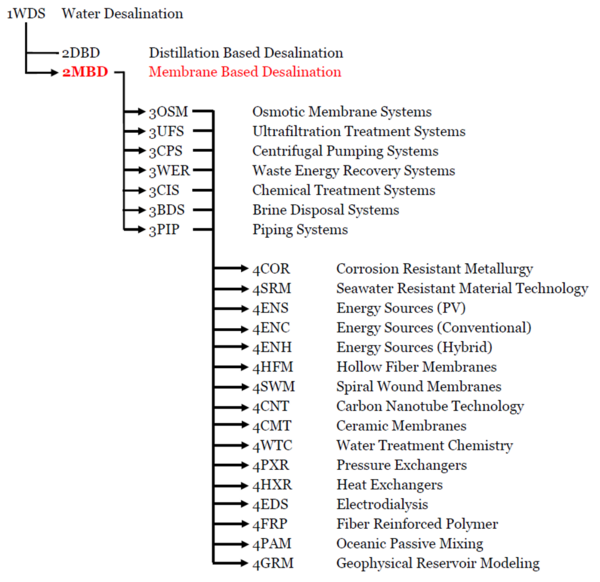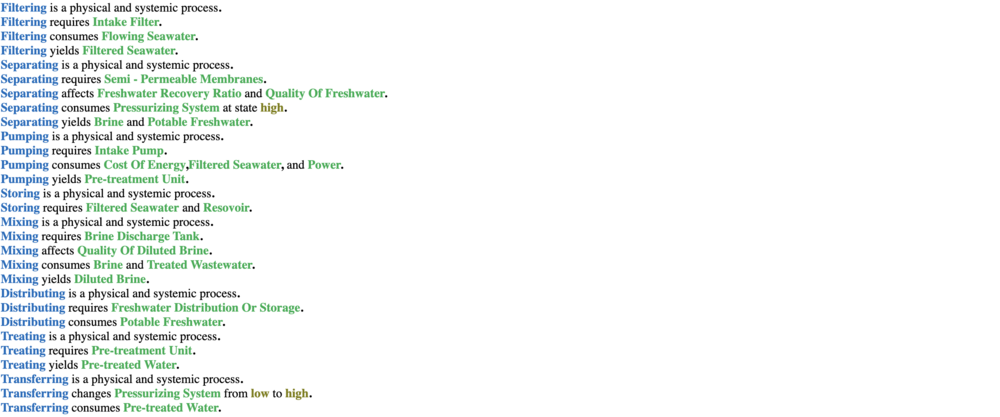Difference between revisions of "Water Desalination"
| (4 intermediate revisions by the same user not shown) | |||
| Line 1: | Line 1: | ||
==[[Roadmap Overview]]== | ==[[Roadmap Overview]]== | ||
* ''' | * '''2MBD''' - Membrane Based Water Desalination | ||
<gallery heights="300" widths ="300"> | <gallery heights="300" widths ="300"> | ||
File:reverse osimosis.jpg|Jungbin Kim, Kiho Park, Dae Ryook Yang, Seungkwan Hong, “A comprehensive review of energy consumption of seawater reverse osmosis desalination plants”, Applied Energy, Volume 254, | File:reverse osimosis.jpg|Jungbin Kim, Kiho Park, Dae Ryook Yang, Seungkwan Hong, “A comprehensive review of energy consumption of seawater reverse osmosis desalination plants”, Applied Energy, Volume 254, 2019, 113652, ISSN 0306-2619, https://doi.org/10.1016/j.apenergy.2019.113652(https://www.sciencedirect.com/science/article/pii/S030626191931339X) | ||
2019, 113652, ISSN 0306-2619, https://doi.org/10.1016/j.apenergy.2019.113652 | |||
(https://www.sciencedirect.com/science/article/pii/S030626191931339X) | |||
Latest revision as of 02:55, 10 October 2024
Roadmap Overview
- 2MBD - Membrane Based Water Desalination
Jungbin Kim, Kiho Park, Dae Ryook Yang, Seungkwan Hong, “A comprehensive review of energy consumption of seawater reverse osmosis desalination plants”, Applied Energy, Volume 254, 2019, 113652, ISSN 0306-2619, https://doi.org/10.1016/j.apenergy.2019.113652(https://www.sciencedirect.com/science/article/pii/S030626191931339X)
Yang, C., Xu, X., & Guo, W. (2019). Predicting the energy consumption of buildings: A review of data-driven techniques. Applied Energy, 240, 123-136. https://www.filtnews.com/reverse-osmosis-for-desalination/
The world's present status on freshwater is progressively getting worse. The United Nations estimates that by 2030, the global demand for freshwater will be 40% higher than in previous years (Jaynes). Dwindling traditional sources of freshwater, population increase, and unpredictable climate change are gradually creating an unsustainable scenario. Given the development in membrane technologies such as reverse osmosis, desalination has been considered an essential means of supplementing freshwater supplies. The desalination process changes seawater into potable freshwater, creating a new and reliable source of freshwater independent of traditional sources. These solutions involve adopting efficient desalination technologies through membrane-based, reverse osmosis systems. These systems can ensure greater efficiency and less energy use than thermal desalination systems (Politano). It comprises several steps, intake, pre-treatment, and filtration through semi-permeable membranes, the procedure would provide drinkable water to sustain demand.
Several emerging technologies, such as Interface Solar Steam Generation and membrane-based desalination, are becoming the most promising developments in the desalination industry. ISSG utilizes solar energy to heat water into steam, which gets condensed into fresh water. It provides complementary technology that could reduce dependence on other energy resources in sunny areas. The technology continues to improve with innovations like hydrophobic graphene-based membranes that further improve salt rejection rates and energy economy (Cai). The second is membrane-based distillation, which couples the thermal process with membrane filtration, showing a very high purity of salient waters (Cai). These technologies address water shortages and meet environmental goals through reductions in carbon footprint and shifts towards renewable energy sources. Such advanced technologies could go a long way toward answering the world's increasing freshwater needs while maintaining ecological sustainability.
Citations
Jaynes, C. H. (n.d.). Global freshwater demand will exceed supply 40% by 2030, experts warn. World Economic Forum. https://www.weforum.org/agenda/2023/03/global-freshwater-demand-will-exceed-supply-40-by-2030-experts-warn/
Antonio Politano et al 2024 J. Phys. Energy 6 021502
Cai, Y., Wu, J., Shi, S. Q., Li, J., & Kim, K.-H. (2023). Advances in desalination technology and its environmental and Economic Assessment. Journal of Cleaner Production, 397, 136498. https://doi.org/10.1016/j.jclepro.2023.136498
Design Structure Matrix (DSM) Allocation
The 2MBD DSM matrix and tree above show the numerous technologies that comprise current membrane-based desalination technology and will contribute to the continued development of highly efficient and lower energy intensive desalination operations of the future. Membrane-based desalination is part of the wider industry initiative pursuing all forms of desalination, including distillation-based desalination (shown above in DSM for reference). The tree clarifies the key enabling technologies necessary for the continued development of 2MBD at the sub-system level including 3OSM (core membrane technology for actively removing salt ions from saltwater), 3UFS (pretreatment and solids removal), 3CPS (providing fluid power to enable process), 3WER (enabling incremental efficiency improvement), 3CIS (allowing for critical chemical treatment processes including coagulation and flocculation), 3BDS (to dispose of brine, the toxic byproduct of desalination, efficiently) and 3PIP (to enable fluid processes and optimize facilities lifespan. These system technologies in turn require the component level technologies shown in the table/tree.
Object Process Diagram - OPD
The Object Process Diagram (OPD) for the 2MBD Membrane-Based Desalination roadmap subject and its decomposition is provided in the figure below. This diagram highlights the core 2SEA product level technology and its associated value-related operand (sea/saltwater) as well as the value related processes required for its transformation. The diagram also portrays the necessary and alternative technological subsystems for the various implementations of 2SEA that enable the value processes, as well as the key Figures-of-Merit (FOMs) by which they are qualified.
An Object-Process-Language (OPL) description of the OPD is displayed below.
Figures of Merit (FOM)
Sources
Jaynes, C. H. (n.d.). Global freshwater demand will exceed supply 40% by 2030, experts warn. World Economic Forum. https://www.weforum.org/agenda/2023/03/global-freshwater-demand-will-exceed-supply-40-by-2030-experts-warn/
Antonio Politano et al 2024 J. Phys. Energy 6 021502
Cai, Y., Wu, J., Shi, S. Q., Li, J., & Kim, K.-H. (2023). Advances in desalination technology and its environmental and Economic Assessment. Journal of Cleaner Production, 397, 136498. https://doi.org/10.1016/j.jclepro.2023.136498
International Filtration News. (2019, October 11). Reverse osmosis for desalination. International Filtration News. Retrieved from https://www.filtnews.com/reverse-osmosis-for-desalination/
Yang, C., Xu, X., & Guo, W. (2019). Predicting the energy consumption of buildings: A review of data-driven techniques. Applied Energy, 240, 123-136. https://doi.org/10.1016/j.apenergy.2019.01.123







